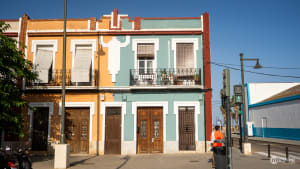
History of Fallas
Fallas is an incredibly rooted tradition in Valencia, but when did it become as we know it today? What are its origins? How has it changed over time?
History of Fallas in a nutshell…
Fallas is a centuries-old Valencian tradition with uncertain origins, possibly rooted in medieval carpenters’ bonfires or pre-Christian equinox celebrations. Over time, it evolved from simple street fires into the grand artistic and pyrotechnic spectacle we see today.
The festival has continuously adapted, adding new traditions, official events, and artistic innovations, culminating in its UNESCO recognition in 2016.
Scroll down for key milestones in its evolution.
As much as Fallas is an undoubtedly Valencian tradition, we cannot really be sure of when the first Fallas was celebrated, as the festival’s origins are so murky and debated. To an extent, we could say it doesn’t even make sense to try and mark a specific point in time for the Fallas birth.
To do that, we would have to define exactly what makes Fallas what it is. Is it the falleras and falleros? Is it the bonfires? Is it the fireworks? Is it the construction of a falla as a sculpture? For each of these questions, dozens of other issues arise. What makes a falla just that? The wood? The intention to mock? Their artistic value? What intrinsically makes a fallera just that? Her official inscription to a committee? Her dress? Her involvement in the festival? What if the festival hasn’t been institutionalised yet?

The truth is, the festival, its customs, and the institutions that revolve around it have all changed incredibly over the years. Traditions have been dropped and then recovered, others abandoned altogether, others created recently and others yet adopted from other locations in the region.
What we can be sure of is that Fallas is something that is nowadays an essential part of Valencian identity and tradition, beloved and cherished by its people. Suffice it to say that there even are expat Valencians who travel back to their hometown every year to help with the organisation of the festival. Let’s dive into its history.
Debated origins
There are two main theories regarding the origins of the Fallas festival, one to do with the festival’s pagan roots, and the other with the Christian origins of the celebration. A third theory combines the two into one, where the Christian impetus behind the festival actually feeds into the pagan one.
Carpenters’ day
One theory finds the origins of the festival in the carpenters’ celebration of their patron saint, St Joseph. Tradition dictates that, during the winter and autumn months, Valencian carpenters used to illuminate their workshops with a parot, a sort of chandelier supported by a wooden pole.
In springtime, when St Joseph’s day came around, the carpenters would put the parots in the street together with unused scraps of wood. As the days were becoming longer, they no longer needed the extra light and were able to burn the parots to celebrate their patron saint.
Over time, the bonfires became richer and the poles more elaborate, to the point of being given human appearances. They soon became a way to mock disliked political figures or known people.

The spring equinox
The other theory has to do with the seasonal celebrations that used to take place around solstices and equinoxes. According to this theory, Fallas is a direct descendant of the spring equinox celebrations that used to take place in the region in ancient times. Right at the turn of winter into spring, people would celebrate the seasonal change with bonfires and festive ceremonies.
The Catholic institutions would then have absorbed this ritual into their own traditions, rebranding it as a celebration related to St Joseph (San José, in Spanish). The final Fallas day, as it just so happens, falls basically on the day of the spring equinox.
History timeline
Although the festival has deep and ancient roots in Valencian tradition, its modern form - how we know Fallas today - has developed mostly in recent times, in the course of the 20th century.
1693 - First documented reference to Fallas
Don Rafael Solaz states in his manuscript that “many fallas or bonfires were set up in Valencia”. There is no mention of ninots in the text, so it is possible that the author was simply talking about street bonfires.
In any case, we can be sure that the tradition had been present in different forms for many years before that.
1886 - Falleros protest
The falleros refused to pay the 60 pesetas fee that the local government had imposed for planting the sculptures in the streets. Just 30 years before, the fee had been 5 pesetas.
1898 - Suspension because of Spanish–American War
As Spain and the US were entering a war, the festival was suspended.
1901 - First prize awarded to the fallas
Valencia’s City Council awarded the first prize to a Fallas monument for the first time in history that year. This motivated falleros to create more and more aesthetically pleasing sculptures, to the point that a new profession was born: the artista fallero.
1927 - First Tren Fallero
A tourist train line carrying visitors from Madrid was instituted on the occasion of Fallas. The last train of this kind ran in 1974.
1931 - First Pregón
Marching bands surrounded the city and marched towards Plaza del Ayuntamiento announcing the beginning of the festivity. This so-called Pregón later evolved into today’s Cridà.
1932 - First Nit de Foc and Semana Fallera
The first official Semana Fallera (Fallas Week) was proclaimed that year. Even though the name referred to a week, the actual celebrative days were two, the 18th and 19th of March.
The first Nit del Foc was also established that year. The event was initially more like a nocturnal Mascletá (mostly loud firecrackers, not many fireworks). In 1942 the event started including a castillo de fuegos artificiales (large firework display).
1933 - First Fallera Mayor
A Fallera Mayor was elected for the first time, even though a female representative of the festival had been elected under different names every year since 1929. The first Fallera Mayor Infantil would be elected in 1941.
1934 - First Exposició del Ninot
The Ninot Exhibition to choose the Ninots Indultats began with a Fallas’ artist proposal.
1935 - First Cabalgata del Ninot
At first the Cabalgata del Ninot was how the Fallas committees transported their ninots to the Exhibition. Over time, the event became independent from the Exhibition and more of a carnivalesque parade for the committees.
1937 - 1939 - Suspension because of Civil War
Because of the Spanish Civil War , Fallas was suspended. Many Fallas committees donated the money raised to the Republican cause.
1939 - Junta Central Fallera
The Junta Central Fallera was created, substituting the pre-existing Comité Central Fallero, created in 1928.
March 1940 - First unofficial Ofrenda de Flores
The Fallera Mayor and the festival representatives spontaneously decided to make an offering to the Virgin on Saint Joseph’s day.
The following year, a group of clavariesas contributed to the tradition. The tradition grew and cemented itself so much that in 1945 it was incorporated as an official act.
1945 - First Mascletà
The first Mascletà, intended as we know it today, was on 11th March. Mascletàs would start being celebrated daily (from 1st to 19th March) only in 1988.
1952 - Fallas Infantiles
This was the first year in which children’s fallas were established and institutionalised as such.
Before that, children used to build their own fallas with cloth scraps. The kids would march around the neighbourhood asking for mats and old junk to burn while they sang the Cant de l’Estoreta (The Rug Song): Hi ha una estoreta velleta ‘pa’ la falla de Sant Josep, el tio Pep?
1967 - Plantà
Although the concept of a Plantà existed before, this was the year when it was established as an event between the 15th and 16th of March, making Fallas longer than just two days.
1987 - First Ofrenda Virgin statue
The Junta Central Fallera commissioned the first Virgin statue to be decorated with flowers. This tradition has since been upheld, and the flowers form a new colourful tapestry on the Virgin’s gown every year.
2016 - Intangible Heritage of Humanity and Nit de l´Alba
The festival was declared part of the Intangible Cultural Heritage of Humanity by UNESCO.
The Nit de l´Alba tradition, initially celebrated in 1966-1967, was brought back on the official programme.
2020 - Suspension because of COVID-19
Following the Ministry of Health’s directives, Fallas and all its events were suspended as a preventive measure to curb the spread of the virus.
2022 - First Cordà in Valencia
The Cordà, traditionally from Paterna, arrived for the first time in Valencia.
Frequently Asked Questions
Here you can find quick answers to all of your questions. Linked, you’ll find the articles or the sections of the articles that can give you more detailed information.
-
Fallas is an event that organically, slowly, and over time developed into the festival that we know today, so there really isn’t an official first edition date.
However, we can say that, although the Fallas tradition is very old (dating back to the Middle Ages or before), the festival started becoming similar to what we know nowadays during the mid-20th century.
-
There are two theories about Fallas’ origins.
The first one is that the festival is a descendant of pre-Christian spring celebrations.
According to the second one, carpenters in the city used to celebrate their patron saint (Saint Joseph) by burning unused wood outside their workshops.
To know more about these two theories, you can check the relevant section of our article.
-
Yes, Fallas was suspended four times over the course of its history (that we know of). The festival got suspended once in 1886 for afalleros protest, once in 1898 because of the Spanish-American War, again between 1937 and 1939 because of the Spanish Civil War, and finally in 2020 because of COVID-19.
-
There are quite a few early written references to Fallas, most of them dating back to the 1700s and 1800s. However, the earliest is from Don Rafael Solaz in his 1693 manuscript. There, he references the many fallas set up in the city.
-
In 1901 the City Council first started giving out prizes to the best fallas, although early non-institutionalised versions of the prize were present before that.
-
A tren fallero is a tourist train line carrying visitors to Valencia on the occasion of the festival. The tren fallero was active between 1927 and 1974.
-
Fallas is an ever-evolving event, many of its traditions get abandoned or brought back continuously - suffice it to say that some were brought back as recently as 2016 and 2022.
However, we can generalise and say that the festival took on the form most similar to what we know today in the last two decades of the 1900s.



















